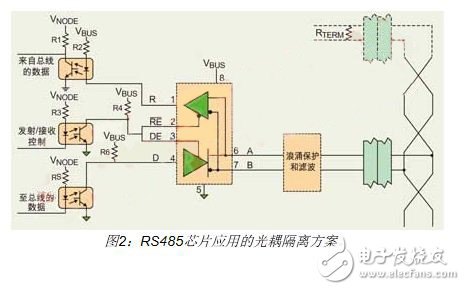The RS-485 interface chip can play a role of level conversion. It converts TTL signals, COMS signals, etc. into differential signals that can be transmitted on the 485 bus, and converts the received 485 differential signals into TTLs that the MCU can recognize. The COMS level has been widely used in many fields such as industrial control, instrumentation, instrumentation, multimedia networks, and mechatronics products. However, in RS485 communication, there are often problems such as short communication distance and poor communication quality. In order to improve the communication quality of RS485, in addition to the terminal-matched bus type structure, the following problems are usually considered in the system design.
Fault protection
According to the RS-485 standard, the receiver's receiving sensitivity is ±200mV, which means that when the differential voltage at the receiving end is greater than or equal to +200mV, the receiver output is high, and when it is less than or equal to -200mV, the output is low. The receiver output is in an indeterminate state between ±200mV. When the bus is idle (that is, all nodes on the transmission line are in the receiving state) and the transmission line is open or short-circuited, the receiver may output a high level or a low level unless special measures are taken. Once a receiver of a node generates a low level, the serial receiver (UART) will not find the start bit, causing communication anomalies.
To solve this problem, many RS485 interface chips introduce fault protection. For example, Shanghai Yinglian Electronics' UM3085/UM3088 input sensitivity is -50mV/-200mV, that is, when the differential receiver input voltage UA-B≥-50mV, the receiver outputs a logic high level, if UA-B≤-200mV, then Output logic low. When the receiver input bus is shorted or all transmitters on the bus are disabled, the receiver differential input is 0V, ensuring that the receiver outputs a high level when the bus is idle and shorted.
2. Lightning protection
The RS-485 interface chip may be damaged by electrostatic shock during use, soldering or transportation of the device. In the case where the transmission line is erected outdoors, the interface chip and even the entire system may be subject to lightning strikes. The use of anti-static or anti-lightning chips can effectively avoid such losses. The UM3085/UM3088 chip integrates ESD protection circuits, human body model ESD protection and machine model ESD protection up to 15kV and 2kV respectively. In addition, Yinglian Electronics also has a complete ESD protection scheme (Figure 1), which makes the system more Reliable operation in harsh transient high pressure shock environments.

Figure 1: RS485 chip lightning protection and surge protection voltage design
The power supply of the RS485 chip usually comes from the transformer. When there is a relatively bad voltage change, some transient surge voltage may appear on the power supply. In the figure, the UM07 can clamp these transient voltages well and protect the interface chip. At the same time, for the two communication ports of the bus, the UESD712 is used for protection, which can achieve a good lightning protection effect.
3. Optocoupler isolation
In some areas of industrial control, due to the complexity of the field, there is a high common-mode voltage between the various nodes. Although the RS-485 interface adopts differential transmission mode and has certain anti-common mode interference capability, when the common mode voltage exceeds the limit receiving voltage of the RS-485 receiver, that is, greater than +12V or less than -7V, the receiver cannot be normal. Work, even in severe cases, can burn chips and equipment.
The solution is to optocouple the system power supply to the RS-485 transceiver power supply through a DC/DC converter (Figure 2), completely eliminating the effects of common-mode voltage and filtering out ground loops and conducted noise-induced interference.

4. Wide signal swing
In RS485 communication, in order to prevent signal reflection, a resistor of 90 to 120 ohms is usually connected to the terminal. The general RS485 interface chip has a swing voltage of only 1.5~1.8V when it has such a resistive load. Therefore, when long-distance communication is performed, the receiver may not receive the signal correctly due to signal attenuation, resulting in errors. code. The UM3085/UM3088 driver increases the output signal swing to greater than 2.2V for greater reliability in long-haul communications. In addition, the UM3085/UM3088 features a slope-limited feature that reduces EMI and reduces reflections when using impedance-missing transmission lines to improve communication quality.
In summary, when selecting the RS485 interface chip, in addition to the parameters such as quiescent current and power supply voltage width range, it is also necessary to consider its fault protection function, antistatic performance, driving capability, and external environment, communication cable and other aspects. Factors in order to build a high quality RS485 communication network.
This Computer Speaker is powered by USB interface on computers or laptops, plug and play, save energy. 3W output brings you high-quality clear binaural sound. Lightweight and portable design makes you can hold it with single hand, save space on the desk. Made of ABS and TPU, which makes this speaker durable and firm. Believe it is a great companion for your computer and laptop.

Usb Tiny Speakers,Usb Electric Speakers,Usb Powered Speakers,Mini Speaker Laptop
SHENZHEN HONK ELECTRONIC CO., LTD , https://www.honktech.com